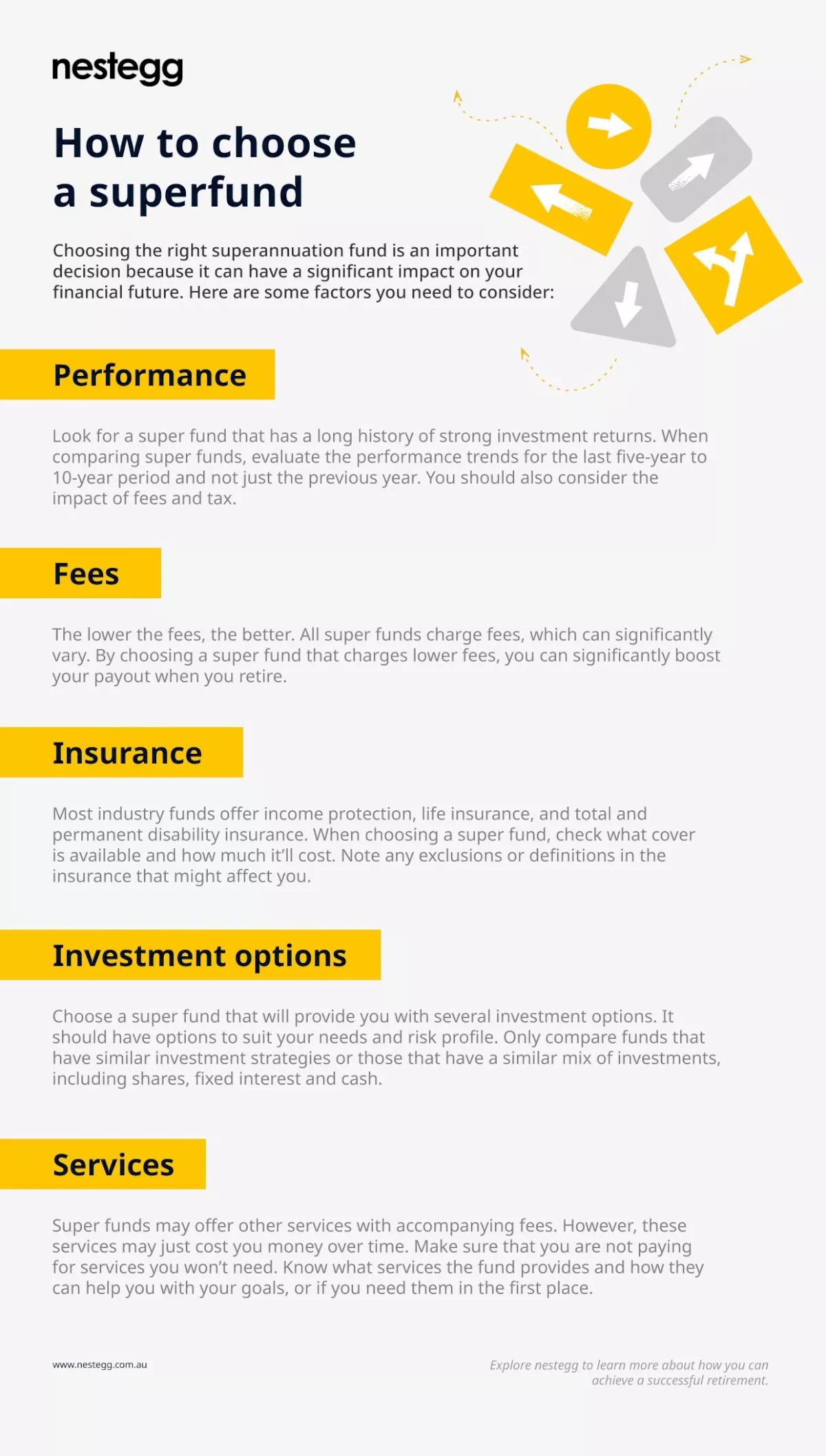Retirement
How to choose a super fund
Your Super Fund is meant to help you secure your retirement benefits, which is why it’s important to take the time to select a fund that is appropriate to your retirement objectives.
How to choose a super fund

However, there are different types of funds to choose from and what works for one person doesn’t necessarily work for another. The best way to choose a super fund is to consider your personal circumstances and objectives.
Below are the basic things you need to consider before investing in any fund.
Types of Super Funds
The type of super fund can determine how a member’s contributions will be taxed and their eligibility for certain benefits, such as commencing a transition to retirement income stream (TRIS).
Below are the different types of super funds and their common features.
- Public Sector Funds
Public sector funds are super funds offered by local, state and federal government institutions to its employees. These are mostly defined benefit funds.
These funds are usually untaxed during the “accumulation phase” until retirement commences, which means its members must pay tax for all the retirement income stream they will receive. However, some defined benefit funds may remain unfunded until the member retires – at which point, the employer will compute the employee’s benefits to finance their fund.
In the case of defined benefit funds, retirement benefits are computed using a predefined formula. This means that defined benefit members will receive the computed amount throughout their retirement regardless of market fluctuations.
- MySuper
MySuper is the government-legislated superannuation product enacted in 2012, which required super fund managers to offer a basic product that will serve as the default fund.
It was designed to be a simple and cost-effective default superannuation account for employees who don’t exercise their right to choose a super fund. MySuper is a basic fund that doesn’t have extra features to avoid unnecessary fees.
Defined benefit funds don’t have this option as MySuper is only available from retail, industry and corporate funds.
- Retail Funds
Retail funds are mid to high-cost super funds offered and managed by investment companies and banks and are typically accumulation funds. This means the final retirement benefits depends on the employer and employee’s contributions but risk is borne by the member.
- Industry Funds
Industry funds are low to mid-cost super funds that are usually restricted to employees of certain industries, but some large industry super funds accept members outside of the industry they serve.
These typically offer a smaller selection of investment options, but have enough to meet its most people’s needs.
Industry funds are not-for-profit funds, so all profits are reinvested into the fund to ensure that all its members can benefit.
- Corporate Funds
Corporate funds are super funds arranged by an employer for its employees and may be managed by the employer’s board of trustees or as a special arrangement with large retail or industry fund managers.
Corporate funds can range from low to high-cost depending on the size of the employer – large companies can avail the fund at a low cost but the same fund can be high-cost for small businesses.
Many corporate super funds are not-for-profit funds that reinvest all their profits in the fund, but some funds will retain a portion of the profits they generate.
- SMSFs
Self-managed super funds (SMSFs) are trust structures set up and managed by a trustee or group of trustees who are also members for the sole benefit of securing their retirement benefits.
SMSFs are known as do-it-yourself super funds because the trustee-members manage all aspects of the fund. This includes collecting contributions, investment strategy creation, filing taxes and ensuring that the fund complies with super and tax laws.
- ERFs
Eligible rollover funds (ERFs) are holding accounts that are not meant to receive any type of super contributions. This is because ERFs are only for super accounts with inactive or lost members and those with very low account balances.
ERFs charge fees to invest what is contained in the inactive or lost fund, but returns may be low or good. Make sure to claim any money you may have in an ERF and consolidate your super into one fund to avoid paying multiple fees for uncertain returns.
Eligibility to Choose a Super Fund
Generally speaking, employees have a right to choose the fund that their super contribution will be paid into. However, some people don’t have this option if they are employed under certain legal agreements.
Check if you can Choose your Fund
There are four conditions that indicate whether an employee is eligible to choose their own super fund. You are eligible to choose your own fund if you are:
- employed under a federal award
- employed under a former state award, now known as a notional agreement preserving state award or NAPSA
- employed under an award or industrial agreement that does not require super contributions
- not employed under any state award or industrial agreement (including contractors who are regarded as eligible employees for super purposes)
If you are eligible, your employer should provide a standard choice form so that you can nominate your preferred super fund.
What Happens when you don’t Choose a Fund?
If you fall under any of the conditions above but don’t exercise the right to choose your own super, your employer is required to enroll you in the company’s default super fund.
Your employer will make salary guarantee contributions in your name to the default super fund until you nominate a different fund.
Super Funds Comparison
It’s important to do due diligence before nominating a super fund as choosing a fund that’s not appropriate for your retirement goals may not meet your financial needs.
How to Compare Super Funds
You can find out more information about a fund by reading its product disclosure statement – a document that indicates the fund’s underlying investments, strategies, fee structure, services and any extra features.
Closely consider the following things:
- Investment options
How many investment options does the fund have? Do the options match your investment objectives, preferences and risk appetite? - Fees
What are the fees and cost for super fund? Scrutinise the fee structure to determine what services are free and paid, as well as how much and how often you will be charged. High fees can hamper the growth of your retirement nest egg, so when choosing between two funds with a similar performance, choose the one with lower fees. - Services
Apart from managing the underlying investments in your super, what other services does the fund manager offer? How likely are you to use the offered services? - Insurance
Does the fund offer insurance cover? If it does, what kinds of cover are available and how much will your premium be? - Performance
How has the fund performed in the short, medium and long term? Choose a fund that has performed well over the medium and long-term. - Extra features
Does the fund have extra features compared to other funds and are they paid or free? Consider the necessity of those features and whether you can get them at a lower cost with another fund.
Super Comparison Websites
Researching hundreds of funds can be time consuming but there are tools that can help you make the process faster.
There are several websites offering free comparison tools available online that can give you an overview of various super funds that fit your criteria. However, comparison sites shouldn’t be the only method you would use to decide on a super fund.
The Australian Securities and Investments Commission’s Moneysmart website also has a superannuation calculator that you can use to generate projections of how much your nest egg can grow.
Changing Super Funds
You may wish to change your super in the future for reasons such as to consolidate your super funds, prolonged poor performance or job change.
There’s no automatic rollover of super but, fortunately, the Australian Taxation Office (ATO) has made things simpler for when you want to change your super. You may choose to do the entire process online or through a paper transaction.
- Online Transfer
Simply access www.my.gov.au and create an account, then link the myGov account to the ATO.
Once the account is linked, the owner will be able to see all their existing super accounts, including the ones that have already been forgotten. From there, it’s as simple as choosing which one to keep and transferring all the balance from other supers into that preferred account.
- Paper Transfer
For paper transfers, fill in the NAT 71223 form (Rollover initiation request to transfer whole balance of superannuation benefits between funds). Once accomplished, send the form to either the fund that will receive contributions or the ones that will send them – not to the ATO.
The filled in NAT 71223 form should be submitted to each fund you have, regardless if they are managed by the same company.
This information has been sourced from the Association of Superannuation Funds of Australia and the Australian Taxation Office.
About the author

About the author


Superannuation
Rest posts healthy returns following a positive end to 2025
Rest, one of Australia's largest profit-to-member superannuation funds, has reported impressive returns in its flagship MySuper Growth investment option for the year 2025. The fund is optimistic about...Read more

Superannuation
Rest marks milestone with first private equity co-investment exit
In a significant development for Rest, one of Australia’s largest profit-to-member superannuation funds, the organisation has announced the successful completion of its first private equity co-inves...Read more

Superannuation
Expanding super for under-18s could help close the gender super gap, says Rest
In a push to address the gender disparity in superannuation savings, Rest, one of Australia's largest profit-to-member superannuation funds, has called for a significant policy change that would allow...Read more

Superannuation
Employment Hero pioneers real-time super payments with HeroClear integration
In a significant leap forward for Australia's payroll and superannuation systems, Employment Hero, in collaboration with Zepto and OZEDI, has successfully processed the country's first payroll-embedde...Read more

Superannuation
Rest launches Rest Pay to streamline superannuation payments and boost member outcomes
In a significant move aimed at enhancing compliance with upcoming superannuation regulations, Rest, one of Australia’s largest profit-to-member superannuation funds, has unveiled an innovative clear...Read more

Superannuation
Rest appoints experienced governance expert to bolster superannuation fund
Rest, one of Australia's largest profit-to-member superannuation funds, has announced the appointment of Ed Waters as the new Company Secretary. Waters, who brings with him over 15 years of extensive ...Read more

Superannuation
Small businesses brace for cash flow challenges as Payday Super becomes law
With the new Payday Super legislation now enacted, small businesses across Australia are preparing for a significant shift in how they manage superannuation contributions. The law, which mandates a tr...Read more

Superannuation
Rest launches Innovate RAP to support fairer super outcomes for First Nations members
In a significant move towards reconciliation and inclusivity, Rest, one of Australia's largest profit-to-member superannuation funds, has unveiled its Innovate Reconciliation Action Plan (RAP). This i...Read more

Superannuation
Rest posts healthy returns following a positive end to 2025
Rest, one of Australia's largest profit-to-member superannuation funds, has reported impressive returns in its flagship MySuper Growth investment option for the year 2025. The fund is optimistic about...Read more

Superannuation
Rest marks milestone with first private equity co-investment exit
In a significant development for Rest, one of Australia’s largest profit-to-member superannuation funds, the organisation has announced the successful completion of its first private equity co-inves...Read more

Superannuation
Expanding super for under-18s could help close the gender super gap, says Rest
In a push to address the gender disparity in superannuation savings, Rest, one of Australia's largest profit-to-member superannuation funds, has called for a significant policy change that would allow...Read more

Superannuation
Employment Hero pioneers real-time super payments with HeroClear integration
In a significant leap forward for Australia's payroll and superannuation systems, Employment Hero, in collaboration with Zepto and OZEDI, has successfully processed the country's first payroll-embedde...Read more

Superannuation
Rest launches Rest Pay to streamline superannuation payments and boost member outcomes
In a significant move aimed at enhancing compliance with upcoming superannuation regulations, Rest, one of Australia’s largest profit-to-member superannuation funds, has unveiled an innovative clear...Read more

Superannuation
Rest appoints experienced governance expert to bolster superannuation fund
Rest, one of Australia's largest profit-to-member superannuation funds, has announced the appointment of Ed Waters as the new Company Secretary. Waters, who brings with him over 15 years of extensive ...Read more

Superannuation
Small businesses brace for cash flow challenges as Payday Super becomes law
With the new Payday Super legislation now enacted, small businesses across Australia are preparing for a significant shift in how they manage superannuation contributions. The law, which mandates a tr...Read more

Superannuation
Rest launches Innovate RAP to support fairer super outcomes for First Nations members
In a significant move towards reconciliation and inclusivity, Rest, one of Australia's largest profit-to-member superannuation funds, has unveiled its Innovate Reconciliation Action Plan (RAP). This i...Read more







